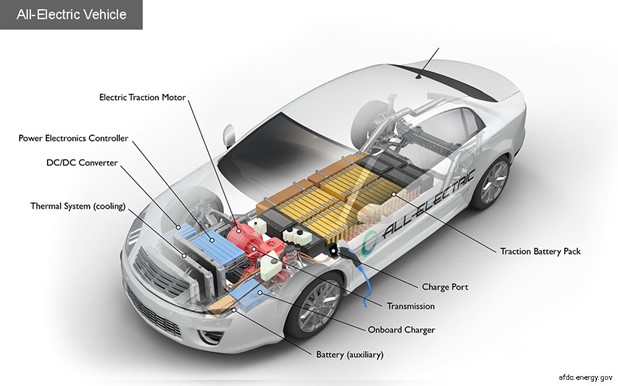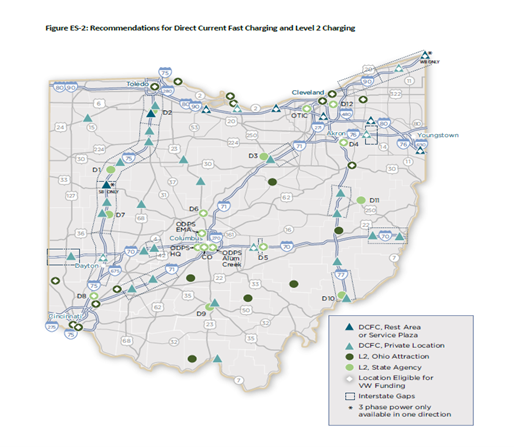The world’s automakers have signaled they intend to make the switch to Electric Vehicles (EVs) in the coming years, which would be the first major development in the type of vehicles we drive since mass production of the combustion engine began. We have seen in recent years the growth of companies like TESLA and how they have changed the EV market leading global automakers to develop plans and vehicles to maintain market share moving forward.
A recent report funded by JobsOhio outlined that automakers are planning $600 B in investment in EVs. This investment comes from legacy automakers such as GM, Volkswagen, BMW, Ford and others) as well as a batch of new EV automaker startups such as Rivian, Lucid, Proterra, Rimas and others. The big question is what regions and state will develop the new generation of EV automobiles and related parts. The answer to that question will be driven by the regions and states that offer an industry strength for EVs—with a large base of existing auto related facilities and success in the new EV battery plant market—but also regions and states that promote the demand side of the EV market tied to the use of renewable energy sources. As an example, In Columbus, Ohio the creation of Smart Columbus, which was done through a competitive grant from the U.S. Department of Transportation has led to the growth of EVs throughout the region. Smart Columbus through both public and private investment expanded the public infrastructure of EV charging stations and the registrations of new EVs has increased by 121% since 2017. 18 communities that have landed EV battery megafactories are also well positioned for supply chain growth in that market.

What can be done if you are not one of the 19 communities without a Smart City grant or an EV battery facility. ___ critical policy decisions can be made by regions and states seeking EV related investments.
- Plan for EV Charging Infrastructure. At the turn of the 20th Century America’s network of public gas stations made it possible for broad ownership and operation of gas-powered vehicles. As automakers and consumer demand moves toward EVs replacing combustion engine powered vehicles for a variety of reasons, both economic and social a vast public infrastructure of EV fast charging stations is needed to support the demand for EVs and the drivers who will depend on it. Planning is where the development of this EV fast charging station needs to begin. In June of 2020 the Ohio Department of Transportation through DriveOhio their division focused on transportation technology did a study, which assessed the needs for EV charging throughout Ohio on the state’s transportation system.
- Build Political Support. Promoting the demand side of EVs requires public officials to make political decisions. They need the support to do so. A group of bipartisan Midwest Governor’s recently formed a collation to support the broad growth of EV manufacturing and infrastructure in the region.
- Capitalize on State & Federal Funding. A number of federal and state level incentive programs have been created to support individuals who purchase EVs and through the recently passed federal Infrastructure Investment and Jobs Act EV infrastructure programs were created to build-out a nationwide network of 500,000 fast charging stations.
- Build EV Charging Network. State regulators or legislators need to create financial incentives for electric utilities and private companies to invest in a network of fast EV charging stations. Electric utilities need to be granted “cost recovery” for their EV charging stations. Local and state governments need to provide sites on government property for fast charging EV stations and also grant property tax abatements for these same stations to encourage their development.
- Prepare Workforce. No region has enough skilled workers for high-wage jobs. Regions and states seeking EV investments need to proactively prepare their workforce for the brave new world of EV related manufacturing. At the same time, regions and states with a base of auto related manufacturing jobs will need to retrain workers engaged in the production of many aspects of the internal combustion engine—EVs lack many of the parts now used for legacy cars.
- Develop Renewable Energy. EVs are in part a response to environmental concerns. Most of the companies seeking to develop EV related manufacturing facilities are focused on using renewable sources of energy. Regions and states seeking EV investments need to develop solar, wind, biomass, water and other renewable sources of energy through regulatory, tax credit and other tools.

Public policy will have a large impact on the location of EV investments. If you would like to learn more about this issue you can reach out to Dave Robinson, Principal [email protected], or Tim Biggam, Director of Government Relations, [email protected].